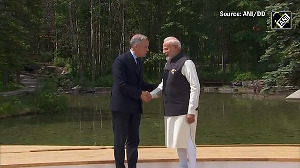'Banks make money because they take the right credit calls. So they need to focus on risk mitigation rather than risk avoidance.'

Engineering and construction conglomerate Larsen & Toubro (L&T) reported a 10 per cent rise in profit for the March quarter and a marginal drop in margins, which led to a 6 per cent decline in its share prices on Thursday.
In a video interview, R Shankar Raman, president, whole-time director, and chief financial officer, tells Dev Chatterjee/Business Standard about the year ahead, the outlook, and L&T's asset sales plans.
Are you surprised at the investors' reaction to L&T results because the share price was sharply down on Thursday?
I'm confident the share price will recover once people understand the overall context of what we are trying to do.
Investors have responded to the margins dropping from 8.6 per cent last year to 8.2 per cent while citing falling efficiency or falling competitiveness, etc -- that's not the correct way and I'm trying my best to tell investors that value creation is our job.
In our India business, the inherent margins are better, and 40 per cent of our order books is international, where the absolute level of margins are lower -- between 1 and 2 percentage points.
But the cash flows and the terms of contracts are far superior in international business.
This enables us to turn around capital much more efficiently and that's why our return on capital employed (RoCE) has moved up by over 200 basis points for the same period when the market is feeling dejected about the margin drop.
Besides, L&T is taking on more complex projects, which means the uncertainties are greater, and they've been chosen to make sure that we are seen at the wider end of the technology spectrum.
With a new government expected to take over next month, do you expect a pickup in infrastructure projects?
Infrastructure projects have created vibrancy in the system and have attracted a lot of foreign technology and capital.
Many are multi-year projects and the government had to just allocate funds as initial equity.
These projects have developed an ecosystem under which goods and services tax and the direct tax have started contributing more to the country's tax kitty.
Rising tax collection has been a major reason why the government has been able to meet its expenditure and social obligations.
These projects have also created a productive engagement for the young population.
Besides, good infrastructure takes people and goods to various parts of the country, and if we have to take advantage of the China plus one strategy, then we would require a huge infrastructure.
Infrastructure has also made India a little less dependent on imports.
This game plan of investment in infrastructure has played out well for the government.
If this government were to continue, I think discontinuity in that policy seems to be throwing away the most powerful tool that has worked for them till now and hence I'm optimistic these allocations for infrastructure will continue.
How will the new Reserve Bank of India proposal to increase provisioning for infrastructure projects affect project development?
There will be greater due diligence in selecting projects. Banks are in the business of taking credit risks. I don't think there is anything like zero-risk credit.
Banks make money because they take the right credit calls. So they need to focus on risk mitigation rather than risk avoidance.
My own sense is that the banks will continue to extend project financing for infrastructure projects, but they would expect the sponsor to possibly demonstrate his own liquidity.
So I don't expect slow down in disbursement, but I expect the diligence over projects to be tighter.
This is good for the country because then we will land projects which are far more certain of completion than having a series of half built projects.
The NCLT is full of half built projects and we can't afford that.
What is the status of asset sales like Hyderabad Metro and Nabha Power by L&T? When do you expect to sell them to free your capital?
We are only left with two concession assets -- Hyderabad Metro and Nabha power projects.
Barring these two, everything else in our current definition is core, and hence there's no reason for us to divest any of that.
Nabha Power is doing well and it is running at 85 per cent of capacity and is generating over Rs 4,000 crore of revenue and Rs 400 crore of profit.
As Nabha is a coal-based power plant, the takers are few because everybody is now trying to evaluate green power project options and we don't want to sell it at distress.
The problem to solve is Hyderabad Metro because it's a Rs 20,000 crore investment.
The government has given a grant of Rs 3,000 crore and we have drawn part of the money and need to draw the balance.
We also have to complete monetising the real estate, which is connected with the metro line.
Around 460,000 people use Hyderabad Metro per day and we need at least 100,000 more.
Feature Presentation: Aslam Hunani/Rediff.com












